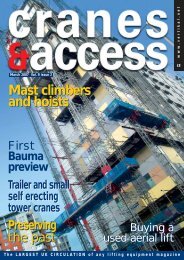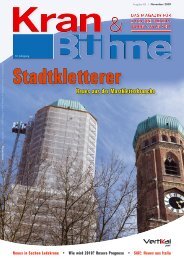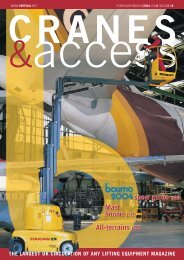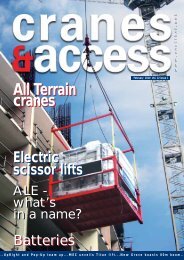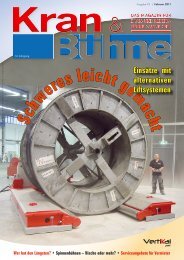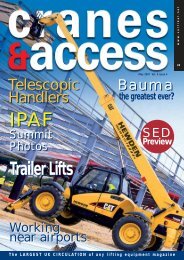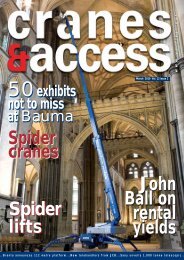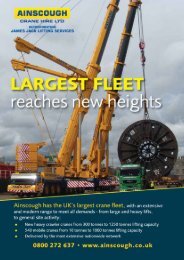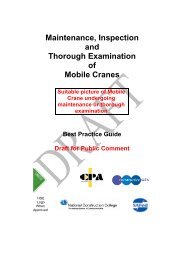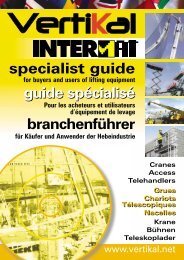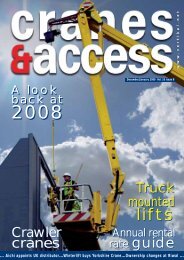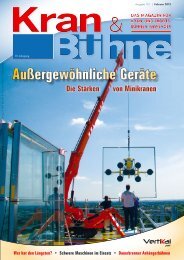c&a - Vertikal.net
c&a - Vertikal.net
c&a - Vertikal.net
You also want an ePaper? Increase the reach of your titles
YUMPU automatically turns print PDFs into web optimized ePapers that Google loves.
The rough<br />
make it<br />
smooth<br />
The Rough Terrain scissor lift has been<br />
around since the birth of the self propelled<br />
work platform but now is an indispensable<br />
item of equipment. We take a look at the<br />
latest developments and trends.<br />
With its sizeable work platform,<br />
decent working heights and an<br />
ability to traverse the typical UK<br />
construction site, the RT scissor<br />
lift is a common sight on a wide<br />
variety of construction projects.<br />
Since our last specific review of<br />
the sector almost three years<br />
ago there have been few major<br />
technical developments - even<br />
the tallest platforms are only<br />
marginally higher at 32 metres.<br />
There have been significant<br />
improvements in terms of choice<br />
and performance with narrower<br />
width models and increased<br />
platform capacities and larger<br />
deck sizes now available.<br />
At the other end of the size<br />
spectrum, there is a flurry of<br />
activity in the compact sector with<br />
a wide choice of product from<br />
Skyjack, Genie, Haulotte, JLG and<br />
MEC and a couple of machines<br />
offering something completely<br />
different such as the Leguan 80SX<br />
and the Manitou 150TP.<br />
A Haulotte H112 SXL.<br />
All change<br />
When Rough Terrain scissor lifts<br />
really took off in the UK and Ireland<br />
in the mid to late 1990's most UK<br />
rental companies bought purely on<br />
price, avoiding what they considered<br />
to be 'frills' such as four wheel drive<br />
and levelling jacks. The rationale<br />
behind this was that contractors<br />
simply would not pay for these items.<br />
When it came to rental rates,<br />
contractors asked for a price for the<br />
given working height and cared not a<br />
jot for the 'bells and whistles' and if<br />
this was not enough the extra options<br />
made the machines more complex<br />
and so increased the running costs.<br />
(Interestingly rental companies in<br />
Ireland did not make the same mistake).<br />
This policy came back to haunt the<br />
fleet owners when it came time to<br />
sell the machines on. Outside of the<br />
UK no one was interested in big<br />
two-wheel drive scissor lifts with<br />
no levelling capability. The resulting<br />
resale values caused a lot of grief<br />
when the UK market for big scissor<br />
lifts took a dive in 2001/2.<br />
These days the market could not be<br />
more different, not only has it become<br />
almost impossible to buy a Rough<br />
Terrain scissor lift without these items<br />
as standard, but ultra high-spec<br />
heavy-duty lifts such as Holland Lift<br />
and JLG-Liftlux are selling exceptionally<br />
well in the UK and Ireland, something<br />
inconceivable 10 years ago. In fact<br />
the UK has become Holland Lift's<br />
c&a<br />
second largest export market<br />
after Germany, which has always<br />
chosen specification over price.<br />
Taking big<br />
scissors indoors<br />
Many manufacturers are now also<br />
offering smaller wheeled, electric<br />
powered versions of these diesel<br />
engine machines - increasingly<br />
with four wheel drive - for use on<br />
finishing or fit-out work inside the<br />
building after the concrete floor has<br />
been laid. There are also a few<br />
manufacturers offering crawler<br />
mounted versions but these have not<br />
caught the user's imagination in the<br />
UK. Ground conditions here do not<br />
justify the extra purchase price and<br />
running costs for these exotic lifts.<br />
Big diesel scissors have typically<br />
been a cladder and roofers tool,<br />
and are particularly popular on<br />
large shed-type construction where<br />
the big extending platforms are<br />
sizeable enough to can carry men<br />
and materials for fitting the external<br />
façade panels. They are also<br />
increasingly used on bigger finishing<br />
jobs such as ducting, fireproofing,<br />
electrical, alarm and sprinkler system<br />
installation. Higher lift capacities<br />
allow a contractor to take up a<br />
great deal more material with him<br />
than in the past and therefore<br />
dramatically step up his efficiency.<br />
In addition to this, the increasing<br />
use of lifting aids and manipulators<br />
to position larger and longer<br />
rough terrain scissors<br />
A Genie GS4390 with double deck extension<br />
lengths of sprinkler tubes requires<br />
more lift capacity. This is also<br />
being driven of course by the<br />
increasingly tight restrictions on<br />
manual handling.<br />
These large distribution 'sheds'<br />
increasingly have roofs<br />
approaching 30 metres, demanding<br />
the use of the largest platforms<br />
for installing services near the<br />
roof line. Until recently the number<br />
of such machines available in the<br />
UK meant that these lifts were<br />
frequently re-rented in from<br />
Holland to the point where Dutch<br />
companies such as Doornboss<br />
kept a fleet of big Holland Lifts<br />
stationed in the UK.<br />
A Liftlux installing ducting.<br />
August/September 2007 cranes & access<br />
17



